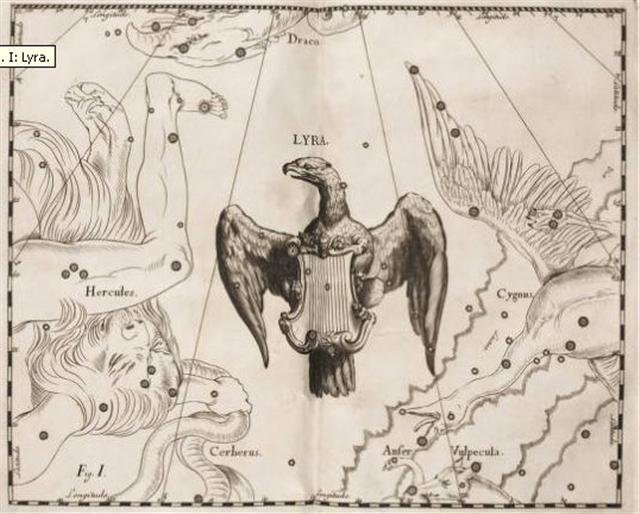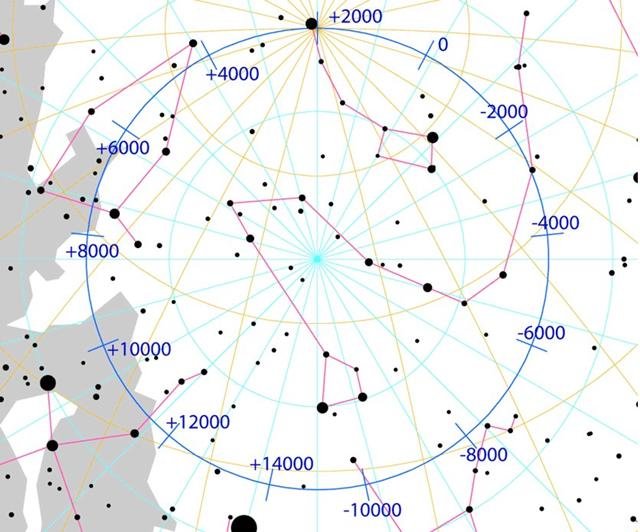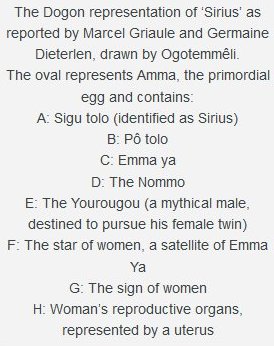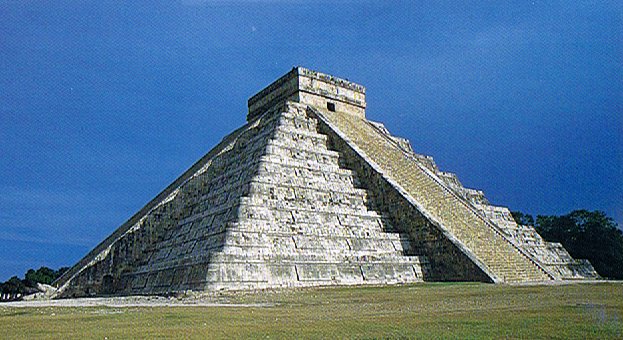Bb10.6
Once upon a time and far back in time it must have been Vega (*281)
who ruled up at the top of the circumpolar world.

But when Sirius (*181 = *281 - *100) took command over
the dates a drastic change seems to have occurred.
... When this tremendous task had been
accomplished Atea took a third husband, Fa'a-hotu,
Make Fruitful. Then occurred a curious event. Whether Atea
had wearied of bringing forth offspring we are not told, but
certain it is that Atea and her husband Fa'a-hotu
exchanged sexes. Then the [male] eyes of Atea glanced
down at those of his wife Hotu and they begat Ru.
It was this Ru who explored the whole earth and divided
it into north, south, east, and west ...
Sirius was south of the equator (in the salty waters of the sea,
i.e. 'female')
and here the north pole was out of sight.
|
CHINESE CORRESPONDENCES: |
|
Elements: |
wood |
fire |
earth |
metal |
water |
|
Cardinal points: |
east |
south |
middle |
west |
north |
|
Planets: |
Jupiter |
Mars |
Saturn |
Venus |
Mercury |
|
Sense organ: |
eye |
tongue |
mouth |
nose |
ear |
|
Taste: |
sour |
bitter |
sweet |
rank |
salty |
|
Crop: |
wheat |
beans |
hirs (Panicum) |
hemp |
hirs (Setaria) |
|
Animal: |
sheep |
hen |
ox |
dog |
pig |
|
Colour: |
bluegreen |
red |
yellow |
white |
black |
... On the day when Tîstar
produced the rain, when its seas arose therefrom, the whole
place, half taken up by water, was converted into seven
portions; this portion, as much as one-half, is the middle,
and six portions are around; those six portions are together
as much as Khvanîras ... I suggest that what they
meant was this shape:
The six 'flames' equals the middle
hexagon in area, which implies that
the 'middle' is
'one-half'. Moreover, I suggest that the middle hexagon
is a region of 'water', whereas the six triangular forms
represent 'land' (with the triangles illustrating
mountains). Consequently the earth should have an equal area
of sea and land. This ancient idea still governed the
travels of Captain Cook. So much sea had been
discovered that there must be a continent somewhere in the
south ...
Therefore the south pole
star Dramasa (*320) ought to be used to mark the new seat of
power.


The Dogon people indicated both Sirius and Women
(→ Virgins,
Adara, ε Canis Majoris, 1 week before
Aludra, the Virgin, η Canis Majoris) by signs similar to the Egyptian X:
... In reference to your question, 'How do
the natives of Easter Island obtain fire?' I [Mr. Croft] have to
answer that they cannot tell. Their forefathers, like the
ancient Romans, had their 'vestal' fires, preserved from ancient
times; but the 'Vestal Virgins' of Easter Island were
gray-headed and gray-bearded old heathen priests. It was a part
of their duty, sacredly attended to, to guard the eternal fire,
which was neutral, together with its guardians, in all wars.
From this sacred fire the whole community -
at one time a large one - could obtain that useful 'element'
from time to time, as they needed it, for culinary and other
purposes. This custom is still kept up by a portion of the
community, while another portion rely on the matches of Mr.
Dutrou-Bornier for their supply ...


The circular sign in the middle of the Dogon version of the Primordial
Cosmic Egg (Amma
→ Amaterasu),
corresponded to its
'Yolk' (Emma ya),
which presumably should be perceived as yellow, and its 'satellite' (F
above) could then represent its nightside reflection in white (→
Snow-white) on
the face of the
Moon.
In ancient times, a tou was someone who had recovered
from an epidemic, but whose illness meant that someone else in
the family had to die. The tou were regarded as portents
of evil. Toutou, lush; fertile (land).
Toûa: Egg
yolk; the colour yellow; soft, fibrous part of tree bark;
toûa mahute, mahute fibres. Vanaga.
It strikes me that in Nordic mythology the male tree named Ash (Ask)
was the counterpart of a female named Embla, which sounds
like the Dogon name for their cosmic yolk, viz. Emma ya.
The yellow Sun was female according to Nordic mythology. Moreover, both the
Oak (→ Jupiter) and the
Ash (→
Mercury) were
characterized by very hard wood (→
Drus) and by their
tendency to 'court the lightning flash'.

The pair of Dogon places named Pô Tolo ought to
correspond to the north and south celestial poles.
Counting from Sirius (*101) up to and including August 13 (*145)
there were 45 days. And day number 45 was February 14:
 |
 |
|
 |
 |
 |
|
Bb10-3 (379) |
Bb10-4 |
Bb10-5 |
Bb10-6 |
Bb10-7 |
|
HELIACAL STARS: |
|
CASTRA = ε Capricorni (327.2),
BUNDA
(Foundation)
= ξ Aquarii
(327.5)
SIRIUS (α Canis Majoris) |
Mahar sha hi-na
Shahū-26 (Western One in the Tail of the Goat)
NASHIRA
(Fortunate One) =
γ
Capricorni
(328.0),
ν
Oct. (328.3),
AZELFAFAGE
(Horse's Foot Track) =
π¹
Cygni,
κ
Capricorni (328.7) |
|
Arkat sha hi-na
Shahū-27 (Eastern One in the Tail of the Goat)
ENIF (The Nose) =
ε
Pegasi,
ERAKIS (the Dancer) =
μ
Cephei
(329.2),
46 CAPRICORNI,
JIH (the Sun) =
κ
Pegasi
(329.3),
ι
Piscis Austrini (329.4),
λ
Capricorni (329.6),
ν
Cephei (329.7),
DENEB ALGIEDI =
δ
Capricorni
(329.8)
*288.0 = *329.4 - *41.4 |
θ
Piscis Austrini (330.1),
λ
Oct.
(330.7) |
KUH (Weeping)
=
μ
Capricorni (331.4),
γ
Gruis (331.5)
*290.0 = *331.4 - *41.4 |
|
12 |
Aug 13 (225) |
14 (409 -
183) |
15 (227) |
16 |
|
Febr 11 (42) |
12 (408 = 365
+ 43) |
13 (226 +
183) |
2-14 (→ 14 *
29½ - 3) |
15 (411 = 350
+ 61) |
|
DEC 12 |
LUCIA (*264) |
14 |
15 |
16 (350 → 347
+ 3) |
|
kua moe ma te tara huki
|
kua ati ra te kava - kua
hakaroa - ko te kava ma te hatu huri |
i vai o amo
hia |
eko te maitaki ma te hokohuki
ku hura hia |
ki te vai o amo
hia |
|
Amo. To carry on one's
shoulders: O Yetú i-amo-ai te tatauró ki ruga
ki-te maúga Kalvario. Jesus carried his
cross up to the Calvary. Amoga, bundle;
to tie in a bundle: he-amoga i te hukahuka,
to tie a bundle of wood. Vanaga. 1. A yoke,
to carry; amoga, burden, load. 2. To
bend, to beat a path. Churchill. Âmo. 1.
To clean, to clean oneself: he-âmo i te umu,
to clean the earth oven; ka-âmo te hare,
ka haka-maitaki, clean the house, make it
good; he-âmo i te ariga, to clean one's
face wetting it with one's hand. 2. Clear;
ku-âmo-á te ragi, the sky is clear. 3. To
slip, to slide, to glide (see pei-âmo).
Ámoámo, to lick up, to lap up, to dry; to
slap one's body dry (after swimming or bathing):
he-âmoâmo i te vaihai rima.
Vanaga. Amoamo. 1. To feed, to graze. 2.
To spread, to stretch (used of keete).
Churchill.
... In China, every year about the beginning of
April, certain officials called Sz'hüen
used of old to go about the country armed with
wooden clappers. Their business was to summon
the people and command them to put out every
fire. This was the beginning of the season
called Han-shih-tsieh, or 'eating of cold
food'. For three days all household fires
remained extinct as a preparation for the solemn
renewal of the fire, which took place on the
fifth or sixth day after the winter solstice
[Sic!]
...

... Once upon
a time there was an old woman who owned a great
potato field where she planted her potatoes in
spring and harvested them in autumn. She was
famous all around for her many varieties of
wonderful potatoes, and she had enough of them
to sell at the market place. She planted her
potatoes 7 in a row, placing her foot in front
of her as a measure from one potato to the next.
Then she marked the place with a bean - which
would also give nourishment to the surrounding
potatoes. Next she changed variety and planted 7
more followed by another bean, and this was the
pattern she followed until all her 214 varieties
had been put down in their proper places. She
had drawn a map which she followed and from
where each sort of potato could be located at
the proper time for its harvest. I was
fascinated, when I happened to stumble on this
Swedish TV program, because my 'once upon a
time' was now and 214 (= 2 * 107) was surely no
coincidence. She knew what she was doing. Let's
therefore count: 214 * 7 (potatoes) + 213
(beans) = 1711. So what? Probably because 1711 =
59 * 29 ...
... Early on Sunday morning, 14 February 1779,
Captain Cook went ashore with a party of marines
to take the Hawaiian king, Kalaniopu'u, hostage
against the return of the Discovery's cutter,
stolen the night before in a bold maneuver - of
which, however, the amiable old ruler was
innocent. At the decisive moment, Cook and
Kalaniopu'u, the God and the King, will confront
each other as cosmic adversaries. Permit me thus
an anthropological reading of the historical
texts. For in all the confused Tolstoian
narratives of the affray - among which the
judicious Beaglehole refuses to choose - the one
recurrent certainty is a dramatic structure with
the properties of a ritual transformation.
During the passage inland to find the king,
thence seaward with his royal hostage, Cook is
metamorphosed from a being of veneration to an
object of hostility. When he came ashore, the
common people as usual dispersed before him and
prostrated face to earth; but in the end he was
himself precipitated face down in the water by a
chief's weapon, an iron trade dagger, to be
rushed upon by a mob exulting over him, and
seeming to add to their own honors by the part
they could claim in his death: 'snatching the
daggers from each other', reads Mr. Burney's
account, 'out of eagerness to have their share
in killing him'. In the final ritual inversion,
Cook's body would be offered in sacrifice by the
Hawaiian King ...
... The Hawaiian woman who was interviewed
chuckled because the assassination of Captain
Cook coincided with the day we have named All
Hearts' Day - when in February 14 (2-14) the
war-god Kuu returned to power ...
 |
|
RIGHT ASCENSION
DAYS AT THE FULL MOON: |
|
A Hydrae (144.1)
VEGA (α Lyrae) |
Creation of our present world
UKDAH (Knot) =
ι
Hydrae (145.4),
κ
Hydrae (145.5),
SUBRA =
ο
Leonis
(145.8)
ALPHEKKA
MERIDIANA
*104.0 = *145.4 - *41.4 |
|
5 Imix 9 Kumk'u
Rishu A.-13 (Head of the
Lion)
ψ Leonis (146.4),
RAS ELASET AUSTRALIS
(Southern Head of the Lion)
= ε Leonis
(146.6)
*105.0 = *146.4 - *41.4 |
VATHORZ PRIOR = υ Carinae
(147.9)
|
υ¹
Hydrae (148.4),
RAS ELASET BOREALIS (Northern Head of the Lion)
=
μ
Leonis
(148.7)
*107.0 = *148.4 - *41.4 |
|
12 |
Aug 13 (225) |
14 (409 -
183) |
15 (227) |
16 |
It was the Southern Head of the Lion (ε Leonis) which
could be seen close to the Full Moon when the Sun was at the
place of the
Son (κ
Pegasi).

When the Northern Head of the Lion (μ Leonis) was at
the Full Moon the Sun was at the star Weeping (μ
Capricorni).
|
Egyptian
jubilation |
 |
Phoenician
he |
 |
Greek
epsilon |
Ε (ε) |
|
Wikipedia points at the Egyptian
gesture with arms held high as a Sign of
jubilation, which may have been the origin (via
Phoenician he) of epsilon.

 |
|
Egyptian
water ripples |
 |
Phoenician
mēm |
 |
Greek
mu |
Μ (μ) |
... Behind me,
towering almost 100
feet into the air,
was a perfect
ziggurat, the
Temple of
Kukulkan.
Its four stairways
had 91 steps each.
Taken together with
the top platform,
which counted as a
further step, the
total was 365. This
gave the number of
complete days in a
solar year. In
addition, the
geometric design and
orientation of the
ancient structure
had been calibrated
with Swiss-watch
precision to achieve
an objective as
dramatic as it was
esoteric: on the
spring and autumn
equinoxes, regular
as clockwork,
triangular patterns
of light and shadow
combined to create
the illusion of a
giant serpent
undulating on the
northern staircase
...
|

|


















